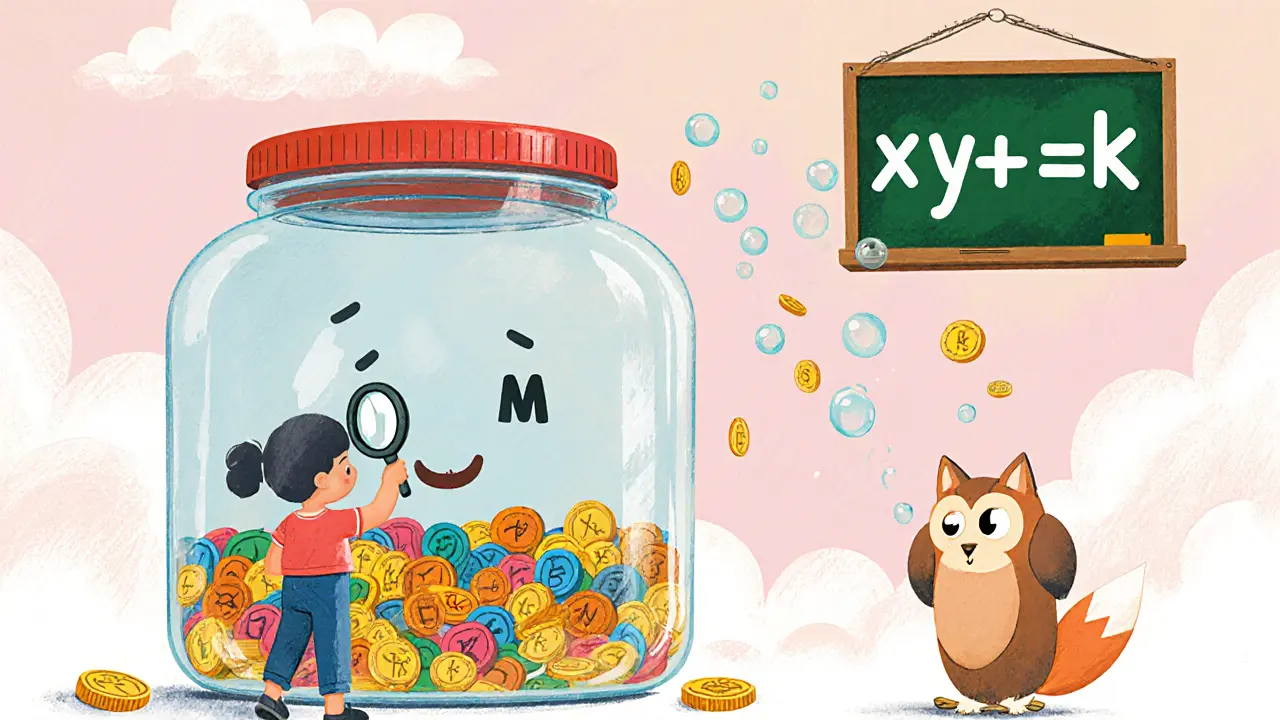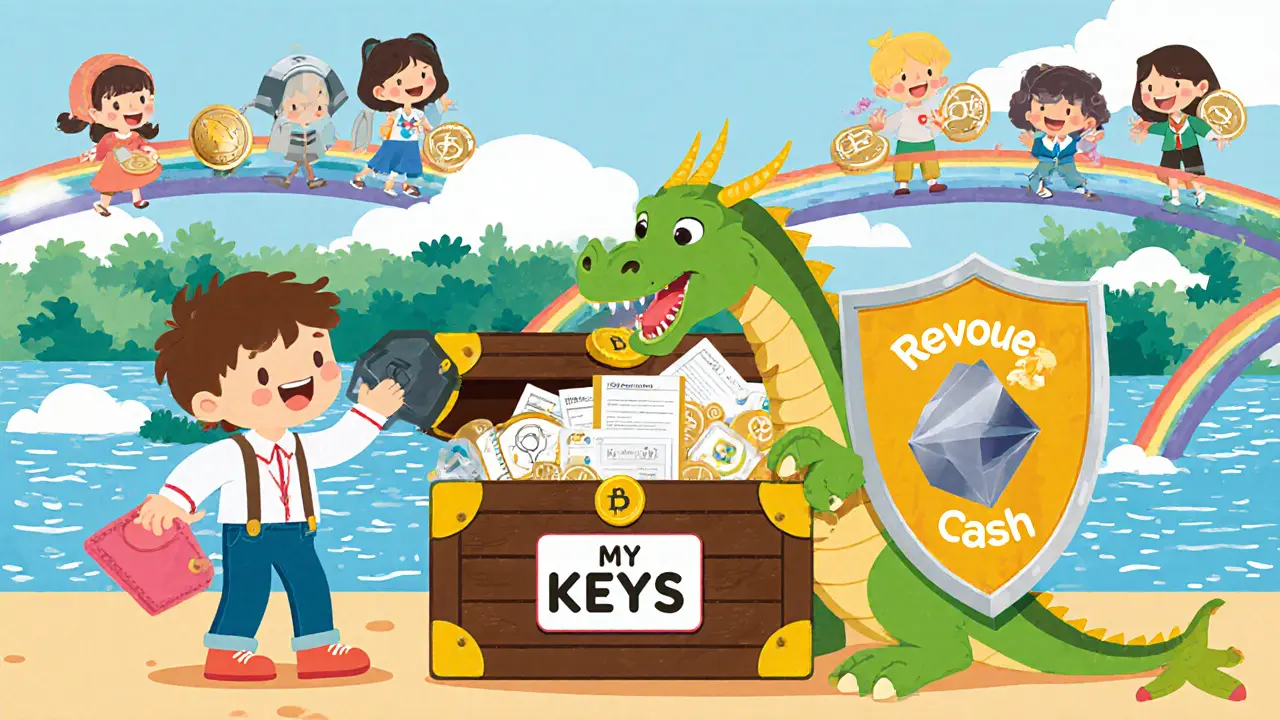Imagine buying cryptocurrency without handing your keys to a company. No ID checks. No bank account. No middleman. Just you, your wallet, and a smart contract that swaps tokens instantly. That’s what a decentralized exchange (DEX) is-and it’s changing how people trade crypto.
Unlike centralized exchanges like Binance or Coinbase, DEXs don’t hold your money. You keep control of your private keys at all times. When you trade on a DEX, you’re not asking someone else to execute your order-you’re letting code on a blockchain do it for you. This isn’t theory. It’s happening right now, every second, across networks like Ethereum, BNB Chain, and Solana.
How Do Decentralized Exchanges Actually Work?
DEXs run on smart contracts-self-executing programs stored on blockchains. These contracts handle trades automatically based on rules written into them. There are three main ways they do this:
- Automated Market Makers (AMMs)-This is the most common model today. Instead of matching buyers and sellers, AMMs use liquidity pools. Think of it like a shared jar of tokens. If you want to trade ETH for USDC, you’re swapping with the pool, not another person. The price changes based on supply and demand inside the pool, using a simple formula: x * y = k. Uniswap, the biggest DEX, uses this system. Its v3 update lets liquidity providers set custom price ranges, making their money work 4,000x more efficiently than before.
- Order Book DEXs-These work like traditional stock exchanges. Buyers and sellers place limit orders, and the system matches them when prices align. dYdX is a top example. It’s faster for large trades and supports advanced features like margin trading.
- DEX Aggregators-These don’t trade directly. Instead, they scan dozens of DEXs at once to find the best price. 1inch and Matcha are examples. If you’re swapping a rare token, an aggregator might split your trade across three different pools to save you money on slippage.
Most people use AMMs. They’re simple, open to anyone, and don’t need orders. You just connect your wallet, pick the tokens, and hit swap.
Why Use a DEX Instead of a Centralized Exchange?
There are clear reasons why millions of users choose DEXs:
- No KYC-You don’t need to submit a passport or driver’s license. Over 98% of DEX users trade anonymously, according to Chainalysis. That’s a big deal for people in countries with strict financial controls or those who value privacy.
- More tokens-Uniswap lists over 250,000 token pairs. Binance, by comparison, has around 1,500. Want to trade a new meme coin? It’s likely live on a DEX before it hits a centralized exchange.
- True ownership-Your funds never leave your wallet. On centralized exchanges, you’re trusting the company not to lose your crypto-or freeze your account. On a DEX, if the platform goes down, your money is still safe in your wallet.
But DEXs aren’t perfect. They’re slower, more complex, and riskier in some ways.
The Downsides: Slippage, Gas Fees, and Smart Contract Risks
Here’s where things get tricky:
- Gas fees-Every transaction on Ethereum costs money. In October 2023, the average fee was $1.20. That’s fine for a $500 trade. But if you’re swapping $20, you might pay more in fees than your trade is worth. That’s why many users switch to cheaper chains like BNB Chain or Arbitrum.
- Slippage-This happens when the price changes between when you click ‘swap’ and when the trade executes. For popular pairs like ETH/USDC, slippage is usually under 1%. For new, low-liquidity tokens, it can be 10% or more. Always set a slippage tolerance-0.5% for stable coins, 2% for volatile ones.
- Smart contract risk-Code can have bugs. In 2022, hackers stole $2.8 billion from DeFi protocols, and 65% of those losses came from DEXs. Most hacks happen because users accidentally approve unlimited access to their tokens. A malicious contract can drain your wallet if you approve it. Always check permissions and use tools like Revoke.cash to revoke unwanted access.
- Impermanent loss-If you provide liquidity to a pool, you’re not just earning fees-you’re also exposed to price changes. If one token in the pair swings hard, you could end up with less value than if you’d just held the tokens. For stablecoin pairs, this loss is usually 5-15% a year. For volatile pairs, it can hit 35% during big swings.
Experienced users see these as manageable risks. Beginners often get burned by not understanding them.

DEXs vs. Centralized Exchanges: A Quick Comparison
| Feature | Decentralized Exchange (DEX) | Centralized Exchange (CEX) |
|---|---|---|
| Who holds your funds? | You (non-custodial) | The exchange (custodial) |
| KYC required? | No (98.7% of users avoid it) | Yes (99% of users must verify) |
| Number of tokens available | Over 250,000 pairs | ~1,500 curated tokens |
| Fiat on-ramps (buy with USD, EUR, etc.) | No | Yes (127+ currencies on Coinbase) |
| Trading speed | 15-30 seconds (depends on network) | Under 1 second |
| Security risk | Smart contract bugs, user error | Hacks, exchange insolvency |
| Market share of total crypto volume | 18.3% | 81.7% |
CEXs win for beginners. DEXs win for control, privacy, and access to new assets. Many users use both: buy crypto on Coinbase, then move it to Uniswap to trade.
Who Uses DEXs-and Why?
DEX users aren’t all the same.
According to a 2023 Crypto.com survey, 78% of new users (under 6 months in crypto) prefer CEXs because they’re easier. But after two years, 63% switch to DEXs. Why? They want more control. They want to earn yield by providing liquidity. They want to trade tokens before they’re listed on big exchanges.
Reddit threads show the split clearly. One user wrote: "Lost $200 in gas fees because I didn’t understand slippage." Another said: "Made 31% APR by staking ETH/USDC on Uniswap v3 with automated yield tools." The difference? Knowledge.
Geographically, 48% of DEX users come from Asia-Vietnam, Thailand, the Philippines-where access to traditional banking is limited. Another 29% are from the Americas. Europe makes up 18%. This isn’t just a Western tech trend. It’s a global shift in financial access.

What’s Next for DEXs?
The future is being built right now.
- Uniswap v4-Launching in early 2024, this update lets developers build custom trading logic. Think of it like app plugins for DeFi. You could create a pool that only trades during certain hours, or one that adjusts fees automatically.
- Ethereum’s Dencun upgrade-Expected in Q1 2024, this will slash transaction costs by up to 100x. That could make DEXs affordable for micro-transactions.
- Regulation-The SEC is watching. In October 2023, Uniswap Labs settled for $50 million over unregistered securities. The EU’s MiCA rules, starting in 2024, will force DEXs to do KYC if they handle fiat. This could change how they operate in Europe.
- Institutional interest-JPMorgan ran simulated DEX trades in 2022. Coinbase bought Matcha, a DEX aggregator, and now offers DEX trading inside its app to 10 million users.
Experts predict DEX volume could hit $5-7 trillion annually by 2025-if scalability and regulation are solved. Right now, they’re still a niche tool. But they’re the only way to trade crypto without asking permission.
How to Start Using a DEX (Step-by-Step)
If you want to try a DEX, here’s how to do it safely:
- Get a wallet-Install MetaMask or Trust Wallet. Never share your seed phrase.
- Buy some ETH or BNB-You need native tokens to pay gas fees. Buy them on a CEX first.
- Connect your wallet-Go to Uniswap or PancakeSwap and click ‘Connect Wallet’.
- Set slippage-For stablecoins, use 0.5%. For new tokens, use 1-2%.
- Check token approvals-After your first swap, go to Revoke.cash and revoke any unnecessary permissions.
- Start small-Try swapping $10 before risking more.
It takes 8-12 hours to learn the basics. YouTube tutorials and Uniswap’s documentation are solid starting points. Don’t rush. Mistakes here can cost you money.
Final Thoughts: DEXs Are the Future-But Only If You Understand Them
Decentralized exchanges aren’t just a tech curiosity. They’re the realization of Bitcoin’s original promise: money you control, without banks. They’re open, transparent, and permissionless.
But they demand responsibility. You’re not protected by customer support. You’re not insured. If you mess up, there’s no refund button.
If you’re ready to take that step, DEXs give you access to a financial system that’s faster, more open, and more powerful than anything banks offer. But only if you learn how to use it safely.
Are decentralized exchanges safe?
DEXs are safe if you know what you’re doing. Your funds stay in your wallet, so no exchange can steal them. But smart contracts can have bugs, and users often make mistakes-like approving unlimited token access. Always check permissions, use trusted platforms like Uniswap, and avoid unknown tokens. Tools like Revoke.cash help you clean up risky approvals.
Can I buy crypto with USD on a DEX?
No. DEXs only trade crypto-to-crypto. To buy crypto with USD, you need a centralized exchange like Coinbase or Kraken first. Once you have ETH, SOL, or BNB, you can move it to a DEX to trade for other tokens.
What’s the difference between Uniswap and PancakeSwap?
Uniswap runs on Ethereum and is the largest DEX by volume. PancakeSwap runs on BNB Chain, which has lower fees and faster transactions. Uniswap has more liquidity and supports more tokens. PancakeSwap is popular for trading new tokens from the Binance ecosystem. Both use the same AMM model, but they’re on different blockchains.
Do I need to pay taxes on DEX trades?
Yes. In most countries, swapping one crypto for another is a taxable event. Even if you don’t cash out to USD, the IRS and other tax agencies treat it as a sale. Keep records of every trade-date, tokens, amounts, and USD value at time of trade. Use tools like Koinly or TokenTax to track this automatically.
What happens if a DEX gets hacked?
If a DEX is hacked, your money isn’t stolen from the platform-it’s stolen from the smart contract. That means users who interacted with the buggy contract lose funds. Your wallet remains safe unless you approved the malicious contract. Always review what you’re approving before signing a transaction. Never click "approve unlimited" unless you trust the contract completely.
Can I earn money by using a DEX?
Yes. You can earn fees by providing liquidity to a trading pair. For example, if you put $1,000 worth of ETH and USDC into a Uniswap pool, you earn a share of all trading fees from that pool. Some users also use yield aggregators like Yearn to automatically compound earnings. Returns can range from 3% to over 30% APR, but you risk impermanent loss if token prices swing wildly.
Why are gas fees so high on DEXs?
Gas fees are high on Ethereum because it’s popular and has limited capacity. When lots of people trade at once, fees spike. To avoid this, use Layer 2 networks like Arbitrum or Optimism, or switch to chains like BNB Chain or Solana, where fees are under $0.10. Ethereum’s upcoming Dencun upgrade will cut costs dramatically by improving how data is stored.
What’s the most common mistake beginners make on DEXs?
The #1 mistake is approving unlimited token access. A malicious contract can drain your wallet if you approve it to spend all your tokens. Always set a limited approval amount or use Revoke.cash to remove permissions after trading. Most losses happen because users don’t check what they’re approving.

18 Comments
Louise Watson
November 9, 2025 AT 02:19 AMDEXs are just code. No one’s in charge. No one’s responsible. You own your keys. You own your mistakes.
Benjamin Jackson
November 10, 2025 AT 00:41 AMThis is actually one of the clearest explanations I’ve read. I used to think DEXs were just for crypto bros-but now I get why people stick with them. No middleman = no one to blame when things go sideways. That’s freedom, even if it’s scary.
Liam Workman
November 11, 2025 AT 09:38 AMMan, I remember my first DEX swap. Thought I was a genius. Approved unlimited USDC. Got a phishing link in DMs. Lost $80. 😅
Then I found Revoke.cash. Now I check my approvals like I check my locks before bed. Still nervous, but smarter. 🙌
Christopher Evans
November 13, 2025 AT 06:50 AMThe comparison table is accurate, but the conclusion oversimplifies. DEXs are not inherently superior. They are a trade-off: autonomy at the cost of usability. For most people, convenience outweighs ideological purity.
Ryan McCarthy
November 15, 2025 AT 04:47 AMDon’t let the fear of gas fees stop you. Try Arbitrum or Polygon. Fees are pennies. The real barrier isn’t cost-it’s confidence. Once you’ve done one safe swap, you’ll wonder why you waited so long.
Abelard Rocker
November 16, 2025 AT 16:41 PMOh wow, another crypto evangelist pretending DEXs are the answer to everything. Let me guess-you also think Bitcoin will replace the dollar and your dog will become a node operator? 😂
Real talk: 98% of DEX users are either degens gambling on memecoins or people who got scammed on a CEX and now hate all institutions. The rest? They’re just waiting for the next bubble to pop so they can say ‘I told you so.’
And don’t get me started on ‘true ownership.’ If you lose your seed phrase, you don’t own anything. You’re just a ghost with a wallet address. The system doesn’t care. Neither should you.
Hope Aubrey
November 18, 2025 AT 09:57 AMLet’s be real-DEXs are a scam for rich white guys who think they’re rebels. Meanwhile, people in Vietnam and the Philippines are getting wiped out by rug pulls and gas fees while Elon tweets about Dogecoin. This isn’t financial freedom-it’s financial colonialism wrapped in blockchain glitter. And don’t even get me started on ‘no KYC.’ That’s just a loophole for money launderers and Putin’s oligarchs.
andrew seeby
November 18, 2025 AT 15:14 PMbiggest tip: always check the token contract before you swap. i once swapped for a token called $WALLET and it was just a scam. i thought it was a typo but nope. it was a trap. also, use 1inch, it’s magic. and if you see ‘approve unlimited’-close the tab. i did that once and lost $300. never again. 🙏
Pranjali Dattatraya Upadhye
November 19, 2025 AT 22:15 PMSo many people forget that DEXs aren’t just tech-they’re culture. In India, where banks lock accounts for ‘suspicious activity,’ DEXs are lifelines. My cousin traded his wheat harvest earnings into USDC to send money home without fees. No one asked for his ID. No one judged him. That’s power. Not hype. Real people. Real change.
Kyung-Ran Koh
November 21, 2025 AT 17:50 PMImportant note: Always verify the token address on Etherscan before approving any transaction. Many phishing sites mimic Uniswap with slight URL changes (e.g., uniswap-v3.xyz vs. uniswap.org).
Also, slippage tolerance should be dynamic-not fixed. For volatile tokens, use 3-5%. For stablecoins, 0.1-0.5%.
And yes-taxes apply. Keep a spreadsheet. Use Koinly. Your future self will thank you.
Missy Simpson
November 22, 2025 AT 19:06 PMI started with $5 on PancakeSwap. Now I’m earning 12% APR on my liquidity pool. It’s not a get-rich-quick thing-it’s a get-smart-slowly thing. 🌱
And yes, I still panic when gas spikes. But I’ve learned to wait. Patience pays. (Literally.)
Tara R
November 23, 2025 AT 04:15 AMThis article reads like a crypto brochure written by someone who thinks ‘smart contract’ is a personality trait. DEXs are a glorified gambling den with a whitepaper. The only thing decentralized is the incompetence.
Michelle Stockman
November 23, 2025 AT 08:45 AMSo you’re telling me the solution to banking corruption… is more code? And more risk? And more people losing their life savings because they clicked ‘approve’ without reading? Brilliant. Just brilliant.
Brian Webb
November 25, 2025 AT 03:27 AMOne thing people don’t talk about: DEXs let you trade tokens that would never pass a CEX’s compliance team. That’s not just freedom-it’s diversity. Some of the most innovative projects in crypto started on DEXs. They’re the wild west, but the wild west built the internet too.
Leo Lanham
November 25, 2025 AT 21:09 PMDEXs? More like Dumb Exchanges. If you need a tutorial to trade crypto, you shouldn’t be trading. Just buy Bitcoin and HODL. Everything else is gambling with extra steps.
Whitney Fleras
November 26, 2025 AT 03:19 AMIf you’re new to DEXs, start with a small amount. Don’t rush. Watch a few YouTube videos. Read the docs. And if you’re unsure-don’t click ‘confirm.’ Wait. Ask. Learn. You’re not behind. You’re being smart.
Colin Byrne
November 27, 2025 AT 03:51 AMLet’s not romanticize this. DEXs are not democratizing finance-they’re weaponizing ignorance. The average user doesn’t understand liquidity pools, impermanent loss, or token approvals. They see ‘earn 20% APR’ and think it’s free money. Then they lose everything. And when they do, they blame the protocol, not themselves. The system doesn’t protect them. It doesn’t even pretend to. That’s not innovation. That’s negligence dressed up as decentralization. And now regulators are coming. When they do, the entire DeFi ecosystem will be forced to conform-or collapse. The ‘no KYC’ fantasy is ending. The only question is whether it will be a soft landing or a crash.
Finn McGinty
November 27, 2025 AT 12:50 PMWhile the technical breakdown is competent, the tone is dangerously naive. You present DEXs as a moral victory, ignoring the reality that 90% of users are either ill-informed or deliberately exploiting regulatory gray zones. This isn’t financial liberation-it’s financial anarchy with a UI. And when the SEC finally moves against Uniswap Labs, the same people who praised ‘permissionless innovation’ will be the first to scream for bailouts. History repeats. The only difference this time? There won’t be a bank to fail. Just empty wallets and a blockchain that doesn’t care.